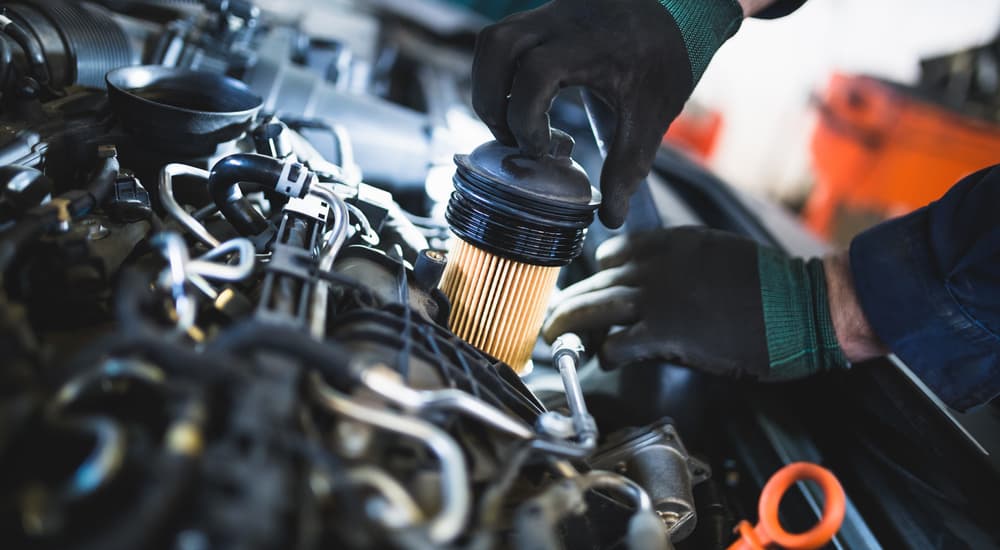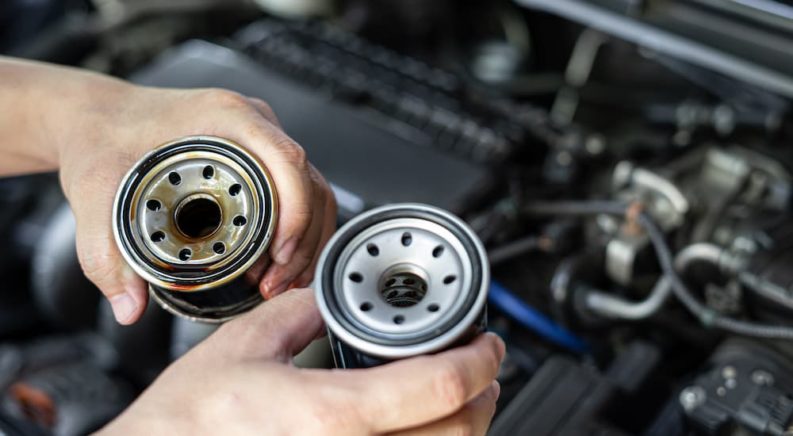When you go to get an oil change, it’s always good to also replace the oil filter. But what does the oil filter do? In the simplest terms, an oil filter removes contaminants from a vehicle’s motor oil, reducing the damage that can occur from the small, hard particles that find their way into the oil through regular wear and tear. While the inner workings of the modern internal combustion engine remain a mystery to most of us, an analogy to the human body can be helpful. If oil were the blood of your vehicle, the oil filter would be the kidneys. It filters out those elements that, in big enough concentrations, can cause serious long-term damage, allowing oil to serve its dual purpose of lubricating and cooling the hard-working engine. Unlike kidneys, these filters can easily be replaced, meaning there’s little excuse for driving around with damaging, gunked-up oil.
How Does an Oil Filter Work?
But how exactly does an oil filter work? At its core, an oil filter is really little more than a mesh of synthetic fiber material packed into a metal cylinder. The cylinder usually features one large hole in the center, surrounded by a ring of smaller holes like numbers on a clock. Unfiltered oil leaving the engine enters these smaller holes and is then passed through the densely packed fiber material. Impurities, like debris, dirt, and metal fragments, are trapped within the fibrous material allowing only the clean oil to pass through. The cleansed oil works its way to the center of the filter until it reaches the large hole in the center, which then feeds back into the engine.
The oil filter is more than just a heavy-duty sieve. In addition to its filtering properties, oil filters also feature an anti-drain back valve which prevents oil from leaking back into the filter once the engine is shut off. More importantly, most modern oil filters are built with a relief valve, which allows unfiltered oil to enter the engine in certain conditions. While it might seem like exactly the opposite of what an oil filter is supposed to do, there’s a reason for that.
When temperatures start to fall, motor oil begins to thicken up, reducing its viscosity and causing it to flow less easily. Even in the depths of winter, this issue will quickly alleviate itself as the rising engine temperature thins out the oil, but it can be a real problem when first starting a vehicle on a frigid January morning. When oil is too thick to flow through the filter, the relief valve bypasses it altogether, sending a small amount of unfiltered oil to the engine to keep things moving smoothly until the oil starts to flow. This same relief valve comes in handy when the oil filter is way past its prime and too clogged with impurities for the oil to easily flow through the dense layers of fibrous material.

How Often Do You Change It?
The less mechanically inclined drivers might be asking themselves, “if oil filters are so important, why have I never seen one?” Given the vital role they play in keeping your engine running smoothly, it seems odd that you’ve never actually laid hands on an oil filter, but that’s just because they’re almost always replaced when you go in for an oil change. This won’t come as any surprise for those who perform their own vehicle maintenance, but for those of us who simply pull up to the local oil change shop and play around on our phones until they tell us we’re done, it can be a revelation. Completing both tasks at once makes sense when you stop to think about it because what good is a fresh batch of oil when it’s just going to pass through the same dirty filter?
Thanks to the close relationship between an oil change and oil filter replacement, knowing when to change your filter is one of the easiest maintenance schedules you’ll ever have to follow. Simply look in your owner’s manual to find the manufacturer’s recommendation on how often to change your oil – typically between 3,000 and 5,000 – and make sure to change your filter as part of every oil change. That might not seem like a lot of mileage to some drivers, but consider this: for every 3,000 miles you travel in your vehicle, the motor oil passes through the filter upwards of 12,000 times. That represents a lot of opportunities for a filter to become clogged and ineffective, so it’s always better to be safe than sorry when it comes to oil and filter changes.
Just remember, this number is a general guideline and doesn’t cover all cases. For example, if you’re regularly putting your vehicle through severe driving conditions such as towing heavy loads, frequenting driving in stop-and-go traffic, or extreme temperatures, your service schedule will likely be accelerated. Some owners’ manuals will include a specific maintenance schedule for severe driving conditions, so make sure to study up.
What Are the Signs of a Failing Oil Filter?
If you’re not sure what sort of condition your oil filter is in, there are several tell-tale signs that could indicate that it’s either nearing the end of its life or has suffered a catastrophic failure. The first sign is the most obvious, if least specific, method for diagnosing any potential issue in your vehicle: the good old check engine light. While the appearance of this bright orange beacon usually isn’t the first warning sign of an issue, it can often serve as a helpful last-ditch attempt to get your attention before the problem turns more serious. While learning anything more specific about a check engine used to mean a trip to the mechanic or an auto parts store, a new breed of diagnostic trouble code (DTC) readers has hit the market in recent years, allowing drivers to pinpoint the issue behind the check engine light with little more than a $20 Bluetooth sensor and a smartphone.
Plugging in the DTC reader might spit out a code like P0520 or P0522, which indicates an issue with the vehicle’s oil pressure sensor. This could be the result of a faulty sensor, but it could also indicate low oil pressure as a result of a clogged oil filter. These codes aren’t always super precise or informative, but they still give you a whole lot more information than a generic check engine light. Some newer vehicles might feature a dashboard light specific to oil pressure, so as always, refer to your vehicle’s owner’s manual for information specific to your particular make and model.
An overheating engine can be another sign of an oil filter that’s past its prime. This typically occurs when an oil filter is so clogged that an adequate amount of oil can’t pass through, resulting in increased friction and heat within the engine itself. All modern vehicles have a gauge that displays engine temperature, and in most cases, it should never pass the halfway mark. A slugging engine can be another sign that it’s time to change your oil filter. As contaminants start to build up within the engine, power capacity begins to decrease, resulting in an unresponsive engine that can be both inefficient and dangerous. If you notice yourself having to push the gas pedal a little harder to get the same level of performance or slow starts off the line, the oil filter could be the culprit.
Lastly, a vehicle’s exhaust can be a handy way to diagnose potential oil-related issues. When everything is in working order, a vehicle’s exhaust smoke should be white to light gray and have a fairly neutral exhaust-like smell. However, a clogged oil filter may cause oil to leak into the exhaust system, resulting in darker, cloudy smoke with the distinctive odor of burned oil. If you notice any of these signs, check your maintenance schedule to see if you’re overdue for an oil change. While the issues aren’t always going to be oil or filter related, it’s a good first step that could end up saving you a lot of time and money.

A Crucial Yet Easy and Cheap Part of Your Vehicle
When you start to peel back the layers, an automotive oil filter is pretty simple to understand. Acting as the first line of defense protecting your engine from harmful contaminants, it’s important to make sure your vehicle’s oil filter is in good working order. Not only does it help prevent engine failure and overheating, it can also extend the life of your oil. While rarely seen by the average driver, oil filters are an important player behind the scenes and are essential in guaranteeing the long-term health of your vehicle’s engine.
Oil filter issues can manifest in all types of ways, from smelly exhaust to reduced gas mileage, so keep an eye out for any noticeable changes in performance and keep a detailed log of service and maintenance. Make sure to get your filter changed as part of every oil change and if you’re unsure about the status of your current filter, head to your local dealership or mechanic and let them give it a once-over. With any luck, you’ll never encounter any serious issues related to your vehicle’s oil filter, but it always pays to have a basic understanding of how it works, just in case.

